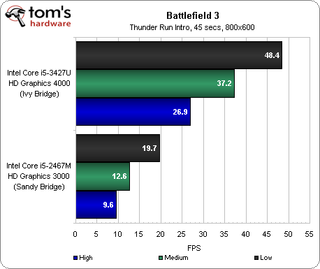Second-Generation Ultrabooks: Faster And Cheaper With Ivy Bridge
Benchmark Results: Low-Resolution 3D Performance

We've seen Ultrabooks with everything from 11.6" to 15.6" screens sporting resolutions between 1366x768 to 1920x1080. The problem is, as the native resolution goes up, so does the demand on your graphics processor. If all you have is HD Graphics 4000, playable performance is clearly possible in World of Warcraft at 1280x720. From there, you can choose whether you want to start increasing the game's resolution or its quality settings.
On the Sandy Bridge-based Ultrabook, you don't have as much flexibility. The game's already running at 50 FPS at 1280x720, leaving little room to jump to 1366x768 and add some of the quality features that'd make World of Warcraft look good. HD Graphics 3000 is simply too underpowered to guarantee playability on even very mainstream titles.

Not surprisingly, then, getting Battlefield 3 up to the point of fluidity is challenging indeed. At 800x600 using the Low quality preset, performance is unacceptable. It takes the Ivy Bridge architecture's HD Graphics 4000 engine to make this title even remotely viable. But when you're forced to dial down to such a low resolution and de-tune fidelity, it's time to find a different device for gaming.
Here's an interesting parting shot, though. There is some flexibility in Intel's Ultrabook definition. A system with a 14" display can have up to a 21 mm-tall Z-height, creating room for discrete graphics in the form factor. Gigabyte's U2442N, for example, qualifies as an Ultrabook, but comes equipped with Nvidia's GeForce GT 640M GPU. Faster configurations are going to command higher prices, naturally, but the U2442N might be worth consideration if gaming on a compact notebook is important to you.
Stay on the Cutting Edge
Join the experts who read Tom's Hardware for the inside track on enthusiast PC tech news — and have for over 25 years. We'll send breaking news and in-depth reviews of CPUs, GPUs, AI, maker hardware and more straight to your inbox.
Current page: Benchmark Results: Low-Resolution 3D Performance
Prev Page Benchmark Results: Battlefield 3 Next Page Integrated Graphics: Image Quality, Examined-
sam_fisher It seems that Ivy Bridge's lower TDP and its HD 4000 comes into its own in the notebook/ultrabook market more so than the PC/gaming one.Reply -
sam_fisher crisan_tiberiuthey should use HD 4000 on every intel CPU, i dont get it why they dont ...Reply
The integrated graphics is built into the processor die and the changes between the HD 3000 and 4000 are physical changes, so they can't just change them without changing the whole CPU.
-
mayankleoboy1 crisan_tiberiuthey should use HD 4000 on every intel CPU, i dont get it why they dont ...Reply
Pricing, TDP, segmentation and PROFIT -
crisan_tiberiu sam_fisherThe integrated graphics is built into the processor die and the changes between the HD 3000 and 4000 are physical changes, so they can't just change them without changing the whole CPU. Yes, i know that :)) but when they designed IVY they should have designed every chip with the HD 4000. The HD 4000 is still outperformed by Liano iGPU if you remember...Reply -
tomfreak Cant u put an older/previous generation desktop and benchmark against it? I cant or couldnt get how a fast a 2.0GHz Ivy vs a similar Nehelem Desktop CPU vs desktop core 2 duo CPU. Many of us buy notebook to replace desktop for casual use, we would like to know what it can do vs our old desktop.Reply
Besides get some older AAA games to bench, nobody play BF3 at Ultra books with HD4000. We wanna see what old games we can max out @ full resolution. -
silverblue I think AMD missed a trick with Llano. Instead of throwing four lowly clocked cores at a mobile processor, perhaps two higher clocked cores would've made much more sense. That way, they could possibly sport a higher clock GPU as well within the same TDP.Reply
Trinity's lower powered, higher clocked cores already look to have partly made up for this, but until the 17W variant comes along, there's no real indication of how it'll measure up to IB ULV. However, we do know that AMD pairs the slower GPUs with the slower CPUs and vice versa, so there's little chance of a, say, 2C/2T/1M CPU with the 7660G GPU. -
DjEaZy ... ok... you compare the Llano to Sandy/Ivy bridge in CPU performance, but not in GPU performance? and why not Sandy/Ivy Bridge to Trinity?Reply
... and Adobe Photoshop CS 5? not CS 6?
Most Popular

